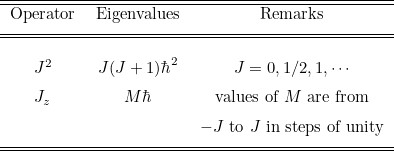$\newcommand{\DD}[2][]{\frac{d^2 #1}{d^2 #2}}$
$\newcommand{\matrixelement}[3]{\langle#1|#2|#3\rangle}$
$\newcommand{\PP}[2][]{\frac{\partial^2 #1}{\partial #2^2}}$
$\newcommand{\dd}[2][]{\frac{d#1}{d#2}}$
$\newcommand{\pp}[2][]{\frac{\partial #1}{\partial #2}}$
$\newcommand{\average}[2]{\langle#1|#2|#1\rangle}$
$\newcommand{\ket}[1]{\langle #1\rangle}$
qm-lec-17002
Consider two sets of angular momentum operators $\vec{J}^{\,(1)}$ and $\vec{J}^{\,(2)}$ \begin{equation} [J_x^{(\alpha)}, J^{(\alpha)}_y] = i\hbar J_z^{(\alpha)}, \qquad \alpha=1,2 \label{E1} \end{equation} such that every component of $\vec{J}^{\,(1)}$ commutes with every component of $\vec{J}^{\,(2)}$. We write \begin{equation} [\vec{J}^{\,(1)}, \vec{J}^{\,(2)}] = 0\,\,\,. \label{E2} \end{equation} It is obvious that $\vec{J}^{\,(1)^2}, \vec{J}^{\,(2)^2}, J_z^{\,(1)}$ and $J_z^{\,(2)}$ from a commuting set. Let us now define total angular momentum $\vec{J}=\vec{J}^{\,(1)}+\vec{J}^{\,(2)}$ then
- $\vec{J}$ satisfies angular momentum commutation relations \begin{equation} [J_x, J_y] = i\hbar J_z \qquad\qquad \mbox{etc.} \label{E3} \end{equation}
- All the three components of $\vec{J}$ commute with $\vec{J}^{\,2}_1$ and $\vec{J}_{2}^{\,2}$.
- It follows from (b) that $\vec{J}^{\,2}$ commutes with $\vec{J}_1^{\,2}$ and $\vec{J}_2^{\,2}$.
The angular momentum commutation relations for $\vec{J}$ imply that the eigenvalues of $J^2$ and $J_z$ are the same as already obtained. In fact the component of $\vec{J}$ along every unit vector $\hat{n}$ has the same eigenvalues as $J_z$ which are given by
Angular momentum eigenvalues.
Given the angular momentum commutation relations it is straight forward to see that one can have two sets of commuting operators. Each of these two sets of operators can have simultaneous eigenvectors. The two commuting sets of operators and the notation for their simultaneous eigenvectors is shown in the table below. 
The vectors $\ket{j_1m_1,j_2m_2}$ listed in the second column of the first row are just the direct product of vectors $\ket{j_1m_1}$ and $\ket{j_2m_2}$ which are eigenvectors of $\vec{J}^{\,(1)2}, J_z^{\,(1)}$ and of $\vec{J}^{\,(2)2}, J_z^{\,(2)}$, respectively. \begin{equation} \ket{j_1m_1,j_2m_2}\equiv \ket{j_1m_1}\otimes\ket{j_2m_2} \label{E4} \end{equation} The problem of addition of angular momenta consists of following two questions:
- [(i)] For a state $\ket{j_1m_1,j_2m_2}$, which has definite values $j_1,m_1$ and $j_2,m_2$ for the individual values of the square, and the $z$- component of the angular momenta, what values of square of total angular momentum $\vec{J}^2$ and $J_z$ are allowed?
- [(ii)]The second part of the problem is to construct the transformation matrix connecting the two sets of simultaneous eigenvectors, one set for each commuting set.
The states $\ket{j_1j_2;JM}$ can be expressed as linear combination of states $\ket{j_1m_1,j_2m_2}$ and vice versa \begin{equation} \ket{j_1m_1,j_2m_2} = \sum_{JM} C(JM; j_1j_2m_1m_2)\ket{j_1j_2;JM} \label{E5} \end{equation} The coefficients $C(JM; j_1j_2m_1m_2)$, appearing n the above equation, are simply the scalar products \begin{eqnarray}\label{E6} C(JM; j_1j_2m_1m_2)&=& \innerproduct{j_1 j_2, JM}{ j_1j_2,m_1m_2} \end{eqnarray} where $M=m_1+m_2$. Conversely the states with definite total angular momenta are linear combinations of the product states \(\ket{j_1m_1,j_2m_2}\): \begin{equation} \ket{j_1j_2;JM} = \sum_{\scriptstyle m_1,m_2\atop m_1+m_2=M} \innerproduct{j_1j_2,m_1m_2}{j_1j_2,JM}\ket{j_1 m_1,j_2m_2} .\label{E8} \end{equation} Since the values of $j_1, j_2$ are the common for all the states, we shall frequently suppress these labels and write the ket $\ket{j_1j_2;JM}$ as $ \ket{JM}$. The coefficients $\innerproduct{j_1j_2,JM}{j_1m_1,j_2m_2}$, written in short as $\innerproduct{JM}{j_1m_1,j_2m_2}$, are known as Clebsch Gordon coefficients and expressions are tabulated in books. The problem of addition of angular momenta consists of finding allowed range of values of $J,M$ and obtaining expressions for the Clebsch Gordon coefficients.
Exclude node summary :
Exclude node links:
4727: Diamond Point, 4909: QM-HOME-I






 ||Message]
||Message]
